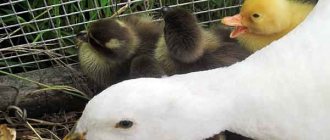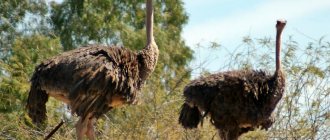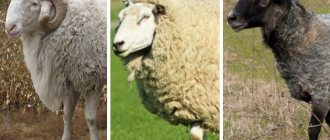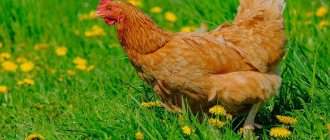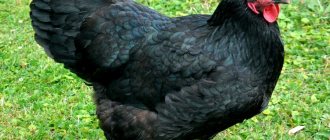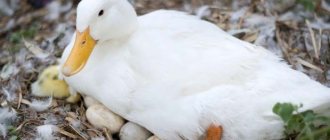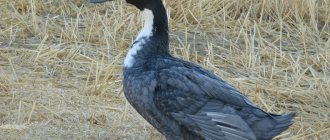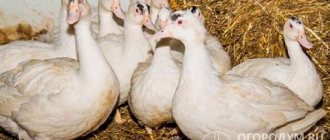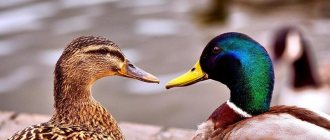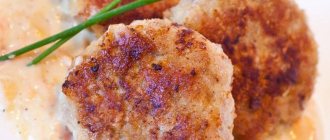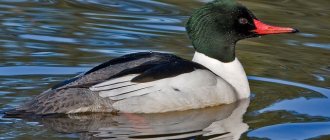Home » Articles about ducks » French ducks
French ducks were bred by Orvia. They are suitable for growing on farms and poultry farms and provide good yield of meat, liver, and eggs.
Description of the breed
French ducks are derived from four lines of the Peking breed. They are known as the Orvia ST5 cross and belong to the meat and egg category. In ST5, the difference in weight between females and males is very pronounced - the drakes are 1-2 kg larger.
Ducklings are born with yellow down, their paws and beak are pink. Adult ducks of the French breed have a massive short neck, a large rounded head, and an orange beak. Their body is dense and elongated. A characteristic feature of birds of both sexes is a wide chest. This is noticeable already at an early stage of growth. The wings are pressed tightly to the body. The tail is small, slightly raised. The paws are strong, set wide, and colored orange. The plumage is white and dense - it is valued on the market, which allows the farmer to receive additional income.
Appearance of broilers
Since the Star 53 duck was bred as a heavy cross of the Peking duck, its external standards are close to it, but has a significantly larger size.
The plumage of the bird is pure white, but slightly creamy is also allowed. The beak and paws are bright yellow. The bird's chest is powerful and wide, protruding well forward, even in not the largest individuals. The duck's back is also massive. The body is oblong and low, which is why the stomach and chest become dirty in the absence of daily bathing.
White French duck STAR-53
Old broilers have a round head shape. The birds' neck is thick, muscular, and strong. The tail is well feathered, strong, pointed upward. The wings are long and strong, but due to their heavy weight, the birds still cannot fly into the air. They are only able to flutter after jumping 2-3 meters forward at a very low altitude.
If you take the bird in your hands, you can feel its considerable strength - large drakes cannot always even be held if you hold them by the sides rather than the base of the wings. Poultry farmers say that in your hands the bird feels like a torpedo.
Productivity characteristics
French ducks are a meat breed with good growth rates. Already at 7 weeks they can be sent for slaughter upon reaching a weight of 3.5-4 kg. The meat at this stage of fattening is juicy, tender, and not very fatty. Such results can be achieved with moderate feed consumption - about 1.88 feed units are required per 1 kg of weight gain.
Duck liver is large - 500-700 g. It is used for the production of liver pates. The breed has high egg productivity - during the year, ducks lay 250-280 eggs weighing 88 g (the maximum is 296 pieces). The product tastes good.
Reviews
Feedback from farmers about Star 53 ducks is overwhelmingly positive.
The main advantages of these birds are presented:
- Their external attractiveness.
- Undemanding to care and living conditions.
- The ability to quickly (the bird is ready for slaughter on 45–50 days of growing) to obtain meat. At this point, the weight of duck carcasses reaches 4.5 kg.
- Large yield of clean meat from each carcass. In terms of fillet yield, the Star 53 breed is superior to all other duck breeds.
- Excellent egg production and impressive egg weight.
- Minimal (no more than 16%) fat content of meat and its excellent taste, allowing it to be used for dietary purposes.
- Low cost, endurance and unpretentiousness of ducklings, not susceptible to disease and characterized by minimal mortality.
- Incredibly fast growth, allowing you to raise at least four batches of ducks during the warm season.
- Maximum profitability of cultivation due to the relatively small amount of feed required.
- The ability to fully reproduce. The eggs of this breed are perfectly fertilized and produce healthy young.
Poultry farmers name the following disadvantages of the breed:
- Tendency to severe soiling of the plumage on the chest and belly, which is a consequence of a very low body position.
- Excessive “talkativeness” of ducks, loudly and actively quack even at night.
- The unsuitability of females for incubating eggs, as a result of which the farmer will have to either purchase an incubator for breeding offspring, or use a duck of a different (most often musky) breed as a brood hen.
- Poor tolerance to damp rooms.
- Insufficient stress resistance.
Breeding Features
Since the description indicates the hybrid origin of the breed, French ducks are not bred within the flock. Incubation material or ducklings have to be purchased. Store eggs before laying at a temperature of +8...+12°C and air humidity of 70-80%. To avoid the development of pathogenic bacteria in a warm, humid environment, the shells are disinfected.
The maximum shelf life of duck eggs is 8-15 days. Subsequently, the percentage of excretion decreases greatly. Incubation takes four weeks:
| Duration (days) | Humidity (%) | Temperature (°C) | Revolution (once a day) |
| 1-7 | 70 | + 38 | 4 |
| 8-25 | 60 | +37.8 | 4 |
| 26-28 | 85 | +37.5 | — |
From the fifteenth to the twenty-fifth day, the eggs are cooled twice a day for 15-20 minutes. The exit is usually amicable, it occurs on the twenty-eighth day, but it may be delayed.
Well-organized care
Straw bedding for ducks
A dry, thick layer of straw bedding will serve as additional thermal insulation for the room in winter. It will also allow the ducks to build nests or hide out to stay warm if the house gets cold. To combat harmful microorganisms, a thin layer of lime fluff is scattered on the floor under the straw.
Regular care involves carefully monitoring the dryness of the litter and replacing it as necessary. In summer, on hot days, the straw can be removed, since the Hungarian will spend a lot of time grazing in order to fully realize her needs for fresh grass. To improve digestion and saturate the duck’s body with the necessary minerals, shell rock or chalk should always be present in a separate feeder. The motley Mulard attracts potential owners with its resistance to typical diseases, which it inherited from its parent breeds.
Have you ever experienced unbearable joint pain? And you know firsthand what it is:
- inability to move easily and comfortably;
- discomfort when going up and down stairs;
- unpleasant crunching, clicking not of your own accord;
- pain during or after exercise;
- inflammation in the joints and swelling;
- causeless and sometimes unbearable aching pain in the joints.
Now answer the question: are you satisfied with this? Can such pain be tolerated? How much money have you already wasted on ineffective treatment? That's right - it's time to end this! Do you agree? That is why we decided to publish an exclusive interview with Professor Dikul, in which he revealed the secrets of getting rid of joint pain, arthritis and arthrosis.
Rules for keeping ducklings
In the first days, the temperature is maintained under the heater +30…+32°C. Lighting at this stage should be around the clock. The temperature is reduced by 1°C daily. They stop at +22°C. At one month of age, the ducklings are moved to a common room, but they are given a separate enclosure.
How much ducks of the French breed will weigh depends on the quality of the starting fattening. Ducklings are ready for an adult diet no earlier than three weeks. In the first days they are fed chopped boiled eggs and millet. Water is provided only in boiled form.
From the third day, well-washed chopped greens are added - alfalfa, knotweed, clover, nettle, and green onions are suitable. From the age of one week, wet mash is prepared based on corn and wheat. It is useful to add fish oil to them.
In good weather, two-week-old chicks begin to be accustomed to grazing on grass - portable enclosures are used. The duration of walks is gradually increased. Ducklings are provided with mineral supplements (egg shells, limestone) and fine gravel. Gradually the diet is expanded.
Feeding of young birds
On the first day, the chicks are given finely chopped boiled eggs, which are well digested by the stomach of young birds. For drinking, add a little manganese to the water so that the liquid is slightly pink. At the next feeding, low-fat cottage cheese or other dairy products are added to the eggs.
Young animals need a sufficient amount of green crushed feed, which is introduced from the second or third day. Green onions, lettuce leaves, young nettles, and duckweed are suitable.
At the age of 1-2 weeks, boiled boneless fish and fish oil are desirable. From the second or third week, small ducks begin to be fed like adult birds.
Conditions for keeping ducks before slaughter
Due to their rapid growth, French ducks are usually raised for up to one and a half to two months. They are kept longer for eggs or for fattening for the liver - in accordance with the description of the breed, the birds have good performance in both areas.
For year-round rearing, an insulated poultry house is prepared; heating is required in winter. The birds are kept on a bedding made of hay, straw, and sawdust. The temperature should not fall below +8°C. The poultry house is kept clean and has good air exchange (no drafts).
The advantage will be the presence of a pond in the walking area. If it is not available, you will have to dig an artificial pond or install troughs for swimming.
Common features
Photos of broiler duck breeds clearly make it clear that their main similarity is their impressive weight, but in reality they have much more in common:
- Fast growth. From the moment the ducklings appear until they are slaughtered, no more than 3 months usually pass. This time is enough to gain muscle mass, and further growth will lead to coarsening of the feathers and difficulties in plucking.
- Tenderness of meat.
- Thin bones. The mass fraction of meat and offal in hybrids is higher than in purebred individuals.
- Simplicity of content. Broilers do not need space. Even being kept in a cage will not affect the health of the bird, but, on the contrary, will lead to faster weight gain. Another plus is that birds do not need to be close to water.
In addition to general positive features, there are also negative ones:
- Cross-breeds are more at risk of avian diseases; their immunity is weaker than that of purebreds.
- Breeding hybrids is possible only if different breeds of ducks are crossed. If there are only broilers in a duck family, there is no need to expect offspring.
- Some of the breeds are voracious, and the rate of weight growth does not correspond to the increase in the cost of keeping ducks.
If the purpose of raising broiler ducks is to sell meat, then you should pay attention to crosses. To breed and sell ducklings, it is worth acquiring purebred birds, the parameters of which are as close as possible to crosses (Peking, musky), thanks to which you can independently increase the duck population.
Feeding adult livestock
The diet of ducks includes:
- cereals (wheat, corn, barley, oats);
- legumes;
- bran;
- cakes and meals;
- yeast;
- grass, aquatic vegetation and vegetables;
- dairy products;
- fish and bone meal, fish waste;
- sources of calcium (shells, shells, chalk).
Digestion requires coarse sand or fine gravel. The frequency of feeding is from two to four times, depending on the conditions of detention (with or without walking) and age (young animals are fed more often). It is convenient to use ready-made mixed feed for feeding - they contain all the necessary components. PC 21-1 is suitable for the starting stage. From one month of age, PC 24-1 is indicated.
Origin story
Above the beak of turkey ducks there is a fleshy growth that makes the bird look like turkeys. The name of the duck also suggests a close relationship with turkeys. But turkey ducks are not hybrids of a duck and a turkey; this popular belief is a misconception. Wild ducks, also called musk ducks (due to their special smell), with leathery growths near the beak, are found in Central and South America. Domestic breeds of Indian ducks are bred from them. Indo-ducks are raised all over the world. The first representatives were brought to Russia from Germany.
White French Indo ducks are distinguished by their snow-white feathers without any shades of gray or yellow. The main feature of the breed - the absence of an obsessive specific duck smell in the meat - was liked by poultry lovers.
Reference: Indo-ducks are also called mute ducks (Europeans call them mutes) due to their inability to quack or make noise loudly, like other representatives of the duck family.
Health
In accordance with the description of the breed and reviews from owners, French ducks have a strong immune system. If the conditions of detention are observed, they get sick infrequently, but problems cannot be ruled out.
When feeding low-quality feed and large products, goiter catarrh may occur. When there is a deficiency of proteins and vitamins A and E in the diet, egg pecking occurs. In young ducks, inflammation and prolapse of the oviduct may be detected - as a rule, this occurs when large eggs are laid.
Infectious diseases develop under unfavorable epidemiological conditions in the district. The most dangerous of them:
- aspergillosis;
- coccidiosis;
- pasteurellosis.
If weakened individuals are identified in the herd, it is necessary to remove them from the rest and show them to a veterinarian. The poultry house must be disinfected. Healthy livestock are given prescribed medicine to prevent infection. It is important to prevent drafts in the room, control the quality of products and comply with feeding standards.
Diseases
ST-5 ducks do not get sick with good care and quality food. If proper maintenance standards are not observed, they are susceptible to the following diseases:
- Avitaminosis.
- Poisoning.
- Inflammation and blockage of the goiter.
- Hepatitis.
- Salmonellosis.
- Parasitic diseases.
- Parasites
- Infectious
- Other
Coccidiosis
How to identify the disease and how to treat it? What is important to know about prevention?
Read
Worms
Worms are round worms (helminths) that cause various diseases and, as a result, serious disorders in the body of birds
Read
Aspergillosis
An infectious disease caused by fungi that affects the respiratory organs and leads to the death of the bird
Read
Pullorosis
Pullorosis (typhoid, salmonellosis): description of the disease, symptoms, treatment, preventive measures
Read
Hemophilosis
Contagious runny nose is a dangerous respiratory disease that can lead to the death of the entire livestock
Read
Pasteurellosis
Basic characteristics of the disease, methods of prevention and basic principles of treatment
Read
Marek's disease
What to do when poultry suffers from Marek's disease (neurolymphomatosis, avian paralysis)
Read
Cloacite
Inflammatory disease caused by errors in feeding and keeping poultry
Read
Varieties of Indo-ducks
Biological classification divides Indian ducks into only 2 varieties - wild and domestic. Wild Indian ducks are predominantly dark in color, and their body size is significantly smaller than their domesticated counterparts (1.5-2 kilograms).
Expert opinion
Zarechny Maxim Valerievich
Agronomist with 12 years of experience. Our best country expert.
Ask a Question
When breeding breeds, breeders focused on increasing weight (mainly the breasts), and also tried to hide with feathers the fleshy growth that spoils the appearance of Indian ducks.
In addition to the white French ones, several more varieties of Indo ducks have been bred, which differ in the color of their plumage. Cultivated species have a phlegmatic character and are easy to handle even for inexperienced poultry farmers.
Popular breeds also include:
- Mulards - bred by crossing Muscovy and Peking ducks;
- red bull - ducks with red-brown feathers, one of the largest (the drake grows up to 5-7 kilograms);
- blue - has a lavender color of plumage, the fluff is light and delicate, the feather is an additional source of profit when breeding;
- chocolate - Indian ducks with cinnamon feathers and white fluff, as a result, each bird has an individual color.
See also
Description and characteristics of ducks of the Bashkir breed, pros and consRead
There is no particular difference in content and character between the breeds; the meat of all is juicy and tender, the differences relate to appearance.
Raising young animals
To raise ducks of the favorite breed, no special conditions or special knowledge are required. These birds easily adapt to the climate of any region. However, there are several rules that must be followed for proper development and good weight gain in young animals. They relate to feeding and caring for ducks.
Care and maintenance
Below are the main points that you need to pay attention to when keeping Favorite breed ducks. Table 4. Features of care and maintenance of ducks of the Favorite breed
Features of care and maintenance of ducks of the favorite breed
Table 4. Features of care and maintenance of ducks of the Favorite breed.
What to pay attention to How it should be Living Ducks can be kept in ordinary sheds or uninsulated enclosures. The main requirements are that there should be no drafts in the barn, and the roof should not leak during rain. But if the owner lives in northern regions with a harsh climate, the room still needs to be insulated
Bathing These birds need regular water treatments. The ideal solution would be a small pond on the site. There, birds will not only be able to swim, but will also find nutrition in the form of algae. If it is not possible to equip a natural pond, you need to install a bathtub on the site. Regular water treatments will help strengthen the birds' immunity and improve the quality of their down. Walking The excellent immunity of the favorites allows them to walk in any open areas, even if the bird has not been vaccinated against major diseases.
For walks, you need to provide a fenced area with enough grass
Daylight It is important to ensure that the ducks have enough light. For proper development, at least 14 hours of daylight are allowed
Therefore, in winter and on cloudy days, the poultry house needs to be provided with lighting at the rate of 60 W per 3 square meters. m corral. Cleaning The floor in the room is covered with a layer of straw 10-15 cm thick. The litter must be replaced as it gets dirty. Also in the poultry house, general cleaning should be carried out regularly, and drinkers and food bowls should be washed every 2-3 days. This will reduce the risk of infectious diseases. Disinfection To disinfect the walls in the poultry house, you need to periodically whiten them with slaked lime.
Favorite ducks are very calm and friendly birds, so they can be kept in the same pen with other birds. They get along well with ducks of other breeds, chickens and turkeys.
Favorite ducks can be kept with ducks of other breeds
Feeding the ducks
Birds of this breed are completely picky about food. They gain weight equally well both on grain nutrition and on mixed feed. The diet of ducks is selected according to the following rules:
- For active mass gain, birds are fed wet mash. Sliced potatoes and carrots, grain, cottage cheese, milk, and fresh grass are added there.
- Favorites need three feedings a day. Breakfast and lunch consist of mash with the addition of vegetables, and it is recommended to give grain for dinner.
- Walks should be organized so that the ducks can always enjoy fresh grass or algae from a natural reservoir.
- Ducks love combined silage. To prepare it, combine cabbage, cabbage leaves and herb meal. This dish helps to increase egg production and improves the immunity of young animals.
Farmers usually do not have any difficulties feeding their favorite. The bird never reacts to food with indigestion. But only if you feed her fresh food. Spoiled food will in any case cause poisoning, due to which the bird will stop gaining weight.
Advantages and disadvantages
Advantages and disadvantages
high yield of dietary meat (60% of weight) with low fat content (3%) and excellent taste;
calm, gentle disposition, making the birds easy to keep;
cleanliness;
developed immunity;
early maturity – 1.5-3 months;
a large number of drakes in the population - males are heavier, raising them is more profitable;
birds love to swim, but can do without a pond;
Mute birds do not disturb the peace of their owners with loud noise.
Birds do not like wet rooms; poultry houses will have to be ventilated to ensure good ventilation.
To maintain immunity, Indian ducks need free space, space - in cages they wither and get sick. Need a place to walk.
the ducks are ready to fly - the pens will have to be protected; ordinary duck enclosures will not work. Owners often trim birds' wings.
White Indian ducks do not have any special requirements for maintenance; they lay eggs for a long time, which allows them to produce offspring twice a year. Keeping Indian ducks does not cause owners much trouble; the breeds have more advantages than disadvantages.
